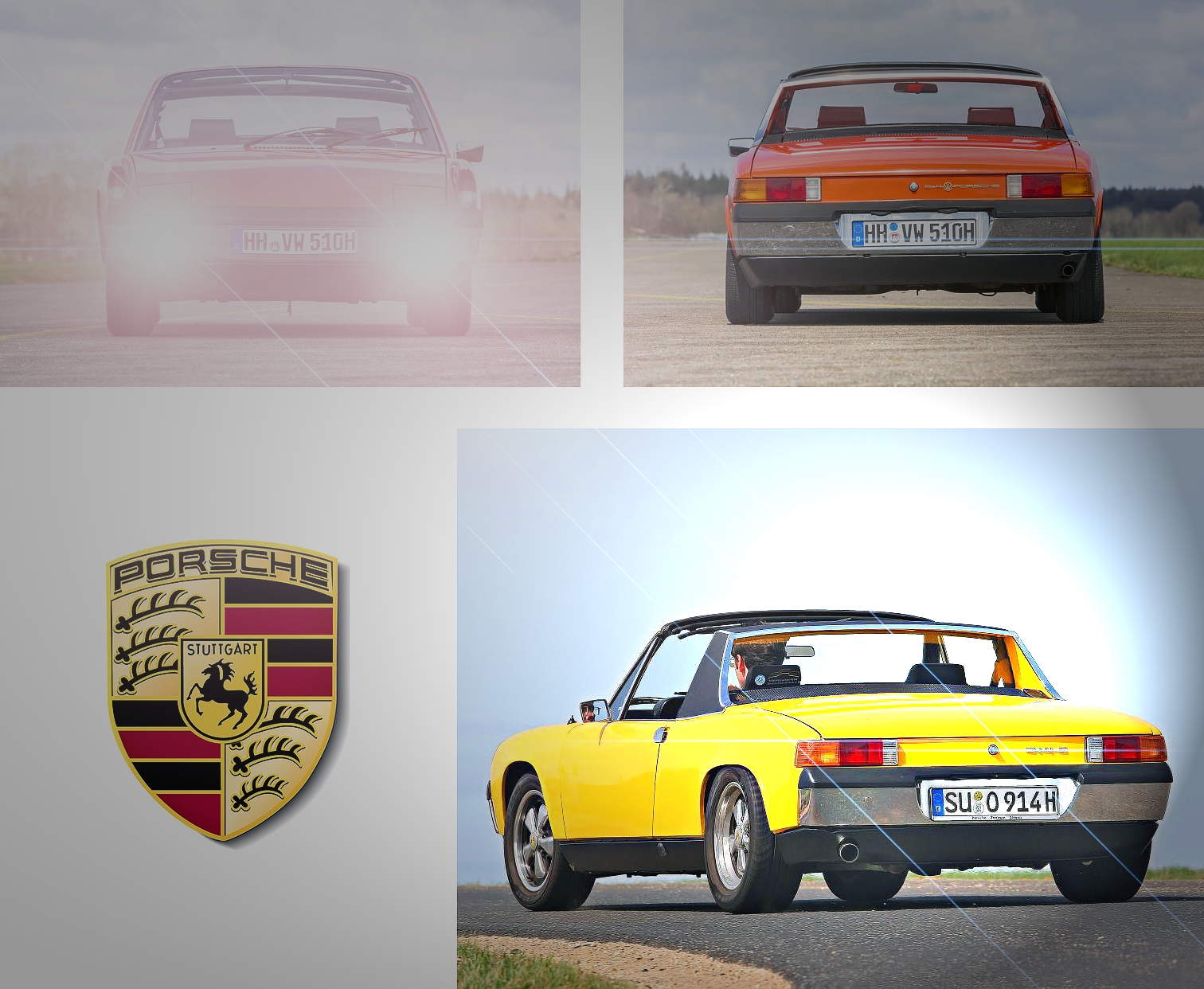
Giant road test – Porsche 914/6 and Porsche 914/4. Evaluating the first modem sports car for the masses. The Porsche 914 can be anything you want it to be. Make it a racer, for real or pretend, and take on your favorite road. Make it fast, make it slow, it’s a very forgiving car. It only seems to require that you enjoy yourself.

Road test – Porsche 914/4
When we all thought about it, the CARS Panel (John Cannon, Phil Hill, and Cary Loftin. Fourth panel member Les Richter, Riverside Raceway President, had to decline participation, because of an emergency), and the staff, no matter which one of the bunch was a sentimental favorite, you had to admit the Porsche was the only really modern automobile of the lot. Small overall dimension, large passenger and luggage space, small engine but good performance, unexcelled cornering and braking capabilities and of course, mid-engine location — the new status symbol after 5-speed gear boxes. Then, there was the specter of the 125 horsepower six with its overhead cams and injection. And that’s another reason why the 914s, the 4 and the 6 polled the votes. It’s sort of like the Road Runner Hemi option, very few buy it but it’s there just in case.
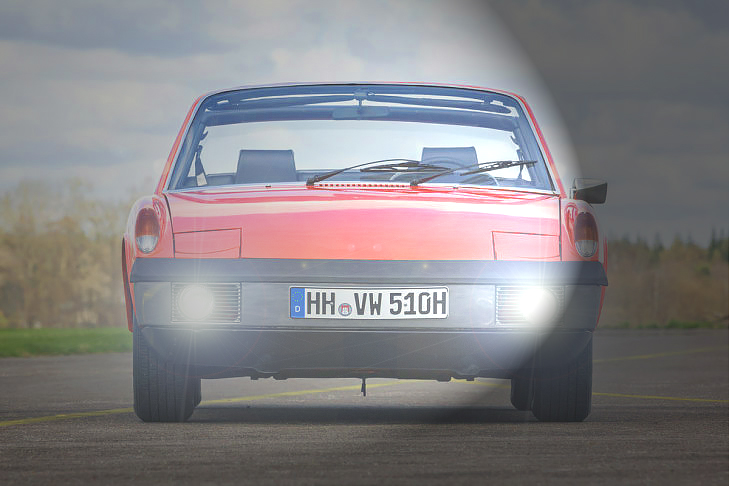
Road test – Porsche 914/4
You cannot say that a 914 has the same visceral appeal as the sleek-back 911 series and yet that kind of locked-in fastback shape was of the ’60s, a kind of last farewell to the good-old pre-WW II days of torpedo Pontiacs and as dead as the Dodo in an age when form must follow function. Just as the shape of the Daytona winning Porsche 917s is a matter of going fast, not looking fast, the car of the ’70s will relate to the ills of our age, not aggravate them.
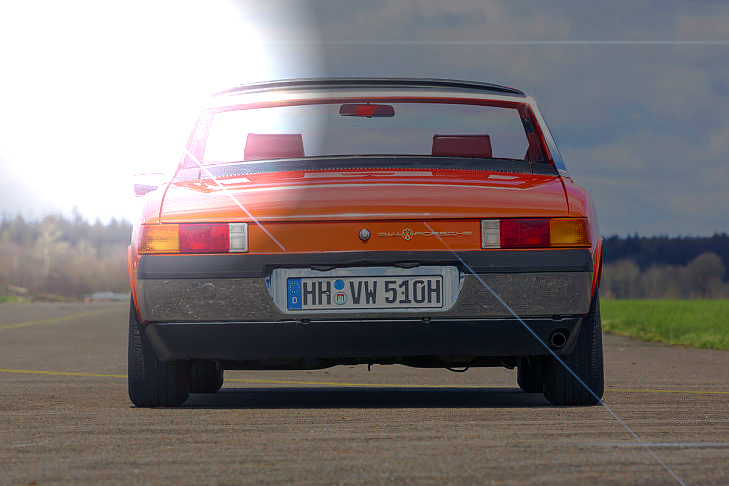
Road test – Porsche 914/4
Somehow, the people in the small plant in Stuttgart, Germany knew this better than we or their other would-be competitors. Perhaps that is really why the Porsche won over eight fine contenders. Sure, it was one of the best handling machines any of us had ever driven, and no one faulted steering response or leg room but the car under-scores better than anything else the shift in automotive design influence out of America. Here we were in one of the first contemporary vehicles of the ’70s and it had nothing to do with Detroit or the UAW or Yankee ingenuity. And you know, maybe that’s precisely why.
{gallery}/media/jw_sigpro/users/0000000042/77{/gallery}
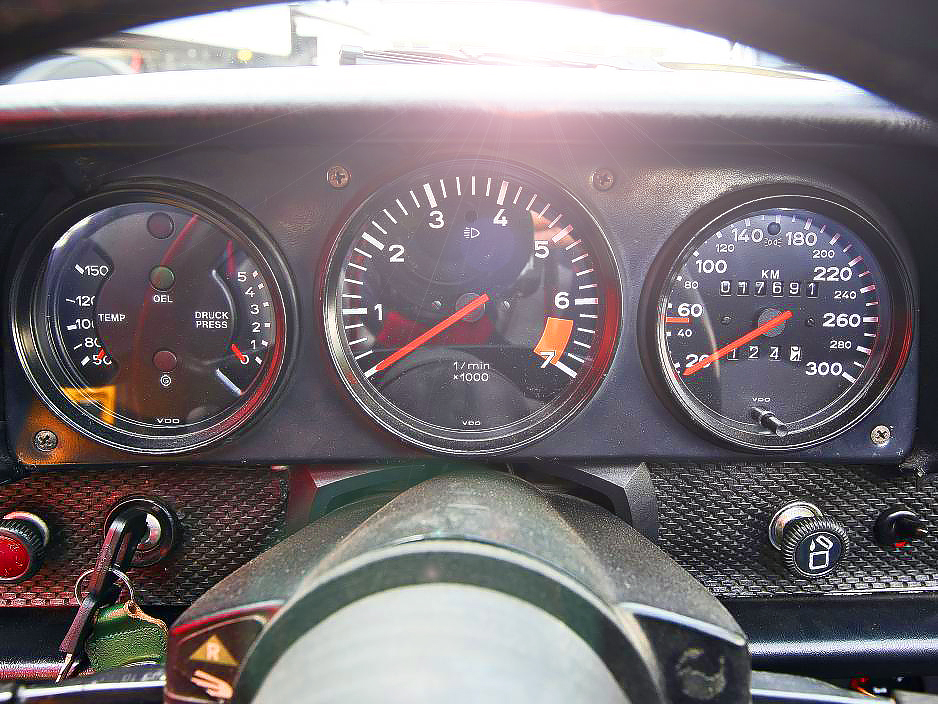
dashboard – Porsche 914/6
It’s all coming back now, my dream of slipping calmly into a Formula 1 car on a starting grid somewhere in Europe, the pre-race activities storming chaotically about, bands playing, flags waving, journalists asking nonsense questions, mechanics screaming frenzied instructions trying to penetrate my cotton-stuffed ears. I adjust my goggles and helmet, check the gauges one last. time. The green flag goes up, quiet consumes the fervor of prior moments. The starter jumps, cars lurch forward as their clutches engage, leaving the grid clothed in the blue haze of tire smoke, gasoline, and the acrid but sweet smells of auto racing. Monte Carlo, Spa, Nurburgring, Watkins Glen, all fall before my skillful ability in a car. Ah, the checkered flags, the victories, parties, women, even a World’s Championship, they are once again vivid in my mind.
But what has stirred the spirit of my repressed, subliminal mind meanderings. The still-lingering sensations of the Porsche 914, that’s what. True, it’s no racer, but for a person too long accustomed to the animal Automobilius Detroitus, the 914 gives the very real impression of a competition machine. There’s the arms-out, straight-legged driving position, super-quick steering response, five-speed gear box, and road holding qualities which seemingly stretch the law of centrifugal force. Remove the fiberglass top, and it’s instant Group 7 racer.
{gallery}/media/jw_sigpro/users/0000000042/914-6{/gallery}
The competition illusion does not end here. There are not 400 throbbing horsepower straining in 455 cubic inches of eight cylinders. There is no record- breaking acceleration. But, in today’s auto market, a safety, pollution and insurance maze, these things are no longer relevant. What distinguishes the Porsche 914 is not its engine size or power, but its placement amidships directly behind the driver. Just like McLaren has it, right?
Many things have been said about the 914. Some think it ugly, underpowered, overpriced. Critics have even accused it of not being a real Porsche. Perhaps these reactions are caused by our Pavlovian conditioned responses to the name Porsche, a symbol which conjures up images of sleek, fast cars that overwhelm their competitors. But whatever the car is or is not, there is a consensus on one point, the 914 is a thoroughly modern automobile.
There is something about the Porsche marque which creates a quickening of our senses. In a too oft used term, German automobiles have charisma, that intangible something which sets a motor car apart and makes it unique in a world filled with mass produced mediocrity. The 914 has Porsche charisma. It turns heads on the street, the sight of it compels people to make comments. Young kids point as you drive along, other motorists peer surreptitiously as you pass and maneuver easily through traffic. Maybe it’s the radical idea of producing a mid-engine sports car for the middle class, or maybe it’s those gold Porsche letters on the engine vent.
When evaluating this automobile, you must consider the reasons behind its design. In the 914/4, powered by a 1,679cc Volkswagen engine which, with the help of Bosch electronic fuel injection, delivers 85 hp at 4,900 rpm, Porsche engineers have tried to fill the void left by the demise of the 912 series. They have succeeded admirably. Here is a car with a west coast P.O.E. price of $3,695 ($3,595 on the east coast) which provides the fun of a sports car with the economy of the reliable VW. Critics claim the 914/4 is a disguised Volkswagen bearing the Porsche label. They seem to forget the 356 model of a few years back which was also VW-powered. No matter, the 914 doesn’t feel remotely like any VW you have ever driven. All Porsche has done is return to an inexpensive, reliable engine and at a lower price than before. For the more discerning enthusiast, there is the 914/6 with real Porsche power from a 1,991cc horizontally opposed six which develops 125 hp at 5,800 revs. It combines the same race car feel of its lower priced brother and has the matching performance. It also costs a Porschesque $6,000.
{gallery}/media/jw_sigpro/users/0000000042/914{/gallery}
Straight-line performance in the 914/4 can not be called outstanding. It is, however, adequate for most driving situations. Quarter-mile times were better than expected with a best e.t. of 18.26 seconds and 75.25 mph. The trick in getting maximum performance from the 85 hp engine is having the car in the proper gear. It soon became apparent during testing that the 914/4 is definitely controlled by gear selection with engine bog if you were one gear too high. The standard five-speed transmission helps in this narrow power-band problem but also creates a few problems. Most notable characteristic of the Porsche servo-thrust synchronized gear box was the rather vague linkage making it sometimes possible to find reverse while hunting for second or even make a power shift from first to fourth. Downshifting, thank the Lord, was somewhat better if approached with a relaxed, controlled attitude. Combined with this vague linkage were rather long shift throws which caused even the swiftest hand to lose a minimum of 1,000 revs during up-shifts. Acceleration and cruise ranges in each gear are fairly limited, as is common with most five-speeds. In defense of the 914/4’s drive train, it must be said that there is a relatively wide useful rpm range but you do tend to run through it rather quickly and since there is little acceleration available below 3,000 revs in any gear, driving in congested areas can give the right arm a good going over.
The 914/6 lacked little in the way of performance, due to a 40 hp increase and only 88 additional pounds for the two extra cylinders. The 6’s power emanates from the four-stroke cycle, air cooled 911E engine. Its cast iron cylinders, light alloy heads, and forged steel crankshaft with eight main bearings provide a 3.15 x 2.60-inch bore/ stroke and an 8.6:1 compression ratio. One overhead camshaft per cylinder bank operates a conventional valve arrangement of one intake and one exhaust for each piston. In addition to its 125 hp rating, the 914/6 engine produces 131 pounds-feet of torque at 4,200 rpm. Performance of the 914/6 is typically Porsche: it won’t win many drag races but watch out on those road circuits. Its best quarter-mile time was 16.05 seconds with a speed of 85.55 mph. Besides the additional horsepower inherent in the 6’s engine, a more positive shift linkage helped the car’s performance. Unlike the 4, the 914/6 exhibits an ease of shifting surpassed by few cars. The throws are still rather long, but since the gears are easy to find, rpm loss is minimal. Problems still occur in downshifts, especially from fourth when you can end up in fifth. The whole thing takes getting used to but once mastered, the 6’s linkage is positive with easy-to-find gear slots. And, there is little right arm fatigue when driving in heavy traffic.
Go power of both 914s is matched by exceptional stopping power. Both cars are equipped with four-wheel disc brakes and combined with the. 914’s light weight (around 2,000 pounds) braking is fast, sure, and straight. Dual brake systems on both models operate the discs with the 6 featuring internally vented front brakes. The 4 has a front/rear disc diameter of 11/11.1 inches while the 6’s brakes have diameters of 11.12 and 11.26 inches. In our panic-stop tests from 30 and 60 mph, the 914/4 halted in 22 feet and 127.5 feet respectively. No wheel correction was needed and the brake balance was so perfect that all four brakes locked simultaneously. Braking action in the 6 was almost a duplicate of the 4 except that distances were a trifle shorter. Once again the automobile displayed a stability which is hard to believe although the right side brakes locked a little sooner due to the driver’s weight.
Stories of Porsche handling are almost as old as the Greek Myths and sometimes as fraught with Homeric imagination. The 914 does not disappoint this living legend. The car is so stable, so flat in cornering, that you want to go quicker and quicker each time until you either exceed the machine’s limit or your own and usually the latter occurs first. Just how much effect the mid-engine design has on the 914’s handling is hard to tell, although there is definitely less unsprung weight than on other cars. The near equal front/rear weight distribution of 45/55 percent doesn’t hurt either. Front suspension of the 914 is straight from the 911 sans anti-roll bar. Components of the independent suspension include transverse control arms, telescopic hydraulic dampers, and longitudinally mounted round section bars, one per wheel. Rear suspension is all new due to the engine placement. It is independent with longitudinal control arms, coil springs, and hydraulic double-acting telescopic shock absorbers.
{gallery}/media/jw_sigpro/users/0000000042/Porsche{/gallery}
If you are accustomed to American sedans, the 914’s ride will probably strike you as firm. Every small bump and road roughness is transmitted to the passenger compartment and the spine-tingling sensation of hitting a rather large dip or bump will satisfy the discerning sports car purist.
Basically, the 914’s steering is neutral and extremely sensitive with the ZF rack and pinion system claiming a 17.78:1 ratio. At low and moderate speeds the slightest steering wheel deflection sends the car off in a new direction. In higher speed ranges this wheel sensitivity diminishes somewhat but still no effort is required to steer the automobile. With no engine up front to exert undo weight on the wheels, you get the impression of power steering without losing the feel of the road surface. Due to its size, 96.5-inch wheelbase, and quick steering response, the 914 is extremely maneuverable in traffic, a definite plus when travelling in congested downtown areas or on crowded freeways. Quite often this maneuvering ability will raise the ire of other motorists who curse enviously as you slip serenely into traffic slots they wouldn’t dare try. One improvement the 914 demonstrated over other Porsches was its stability in the wind. Unlike the 911 which was buffeted about, the 914 experienced no severe effects due to winds and also did not hop from rut to rut at any speed. High speed cornering in the 914 is an enjoyable experience with mild doses of over and understeer evident on occasions although the basic cornering characteristics are neutral. As long as you enter a turn at the proper speed, the car reacts as commanded and does so quite willingly. If, however, the corner is entered in an underpowered attitude, the 914 will plow past the point of entry only to recover when the proper amount of power is added. Oversteer of a very gentle and controllable nature was encountered when really pushing the car. With no weight directly over any of the wheels they would smoothly lose adhesion in unison sending the car into a confident and predictable drift. There was none of the rear end whipping movements so common in other Porsches once they reach the limit of adhesion. Even if a driver did something really stupid, up to and including hitting the brakes in a turn, the 914 would initially get out of shape but then return to the proper line when the mistake was corrected. It is a most forgiving car. With the 6, cornering became a real pleasure, bordering on ecstatic since you could enter and exit a turn faster. The automobile’s cornering ability, according to Porsche-Audi Competition Director Richie Ginther, is on a par with the 911S.
Styling is a strictly personal thing, either you like the 914’s looks or you don’t. People say the car grows on them mostly after seeing it in traffic; it is one of few automobiles ever made that looks better moving than standing still. Without a doubt, the automobile is distinctive and difficult to miss. Obviously the 914’s design was born out of necessity to provide the maximum of looks, side and rear visibility, and maximum “air-wash” through the engine compartment for cooling. The three are not always compatible. The unique-looking basket-handle roll bar is probably the main cause of styling dissatisfaction. It appears somewhat truncated and abrupt and maybe could have been made a little more streamlined without seriously hampering side vision. However, with the top removed, the roll bar is not as objectionable as before and when the flip-up headlamps are turned down the 914’s body lines are smooth and really con-temporary. It boils down to the fact that the 914 is not only engineered as a modern vehicle but styled as one as well, a rare commodity in America today.
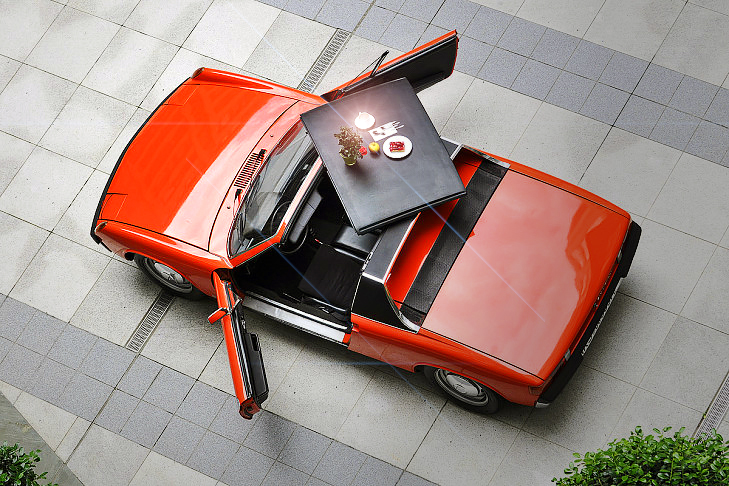
Interior appointments are spartan in the best Porsche tradition. The dash-board is totally dominated by a huge tachometer with the speedometer on one side and fuel gauge on the other. Unfortunately, in the 914/4 there are only idiot lights to indicate oil pressure and engine temperature. In the 6 this problem was partially alleviated by installing a temperature gauge but retained the oil light. A two-speaker radio is placed in mid-dash fashion and can be reached only by the passenger unless the driver wishes to throw a shoulder out of joint. Heating and ventilation controls are located close to the driver and do their duties with the utmost efficiency.
Seating comfort in the 914 is exceptional for a car so small. Even a person over 6 feet can assume an arms-out driving position and be able to sit straight-legged. Apparently European designers recognize the fact that some people are taller than 5 feet 8 inches, a concept more American auto makers should adopt. Only the driver’s seat is adjustable fore and aft with a movable foot stool provided for short-legged passengers. Although leg and lower back support is good, the driver’s seat also tilts to provide more. One disappointing factor of the seating situation in the Porsche, and true in most new cars, is the mobility-limiting seat-belt arrangement. An inertia-controlled harness would be a definite improvement.
With the engine placed directly behind the seat we expected excessive engine noise. While there is a little at low speeds, highway driving is surprisingly quiet with only a gentle hum generated by the motor. Most noise emanates from the wind and even it isn’t too bad unless, of course, the top is removed.
Luggage capacity in the 914 has got to be one of the modern wonders of the world. Since there is no engine to occupy either front or rear, both are reserved for trunk space. Two people would find it difficult to pack enough things to completely fill the separate compartments. Even with the top off and stored neatly on its brackets in the rear trunk, there is still enough room for three suitcases. The front compartment contains the gas filler, spare tire, and space for more luggage.
So there you have it, the Porsche 914, a first of a kind automobile. With other mid-engine cars designed for you and me due on the market shortly, Porsche has beat its competition to the punch. Incorporating a progressive engineering philosophy based on racing, economical operation and fun driving, the 914 is the modern motor car, hopefully a harbinger of things to come. And don’t be surprised if, after driving one, you wake up at night kissing an imaginary race queen and accepting plaudits on your first nine. The Porsche 914 can do things like that to you.
| Car |
Porsche 914/4 |
Porsche 914/6 |
| Made as | Germany, Porsche AG | |
|
Sold |
1969-1976 | |
| Number built | 115,646 | 3,332 |
| Construction | All-steel monocoque, Body/Frame Construction: Welded, unitized | |
| Engine | air-cooled, pushroad opposed, 4 cylinder, Bore and Stroke 3.54×2.60 ins. (90×66 mm) |
SOHC opposed, 6 cylinder, air-cooled, flat-6, Bore and Stroke 3.15×2.60 ins. (80×66 mm) |
| Displacement | 102.3 c.i. (1679cc) |
121.5 c.i. (1991cc) |
| Max power | 85bhp @ 4900rpm |
125bhp @ 5800rpm |
| Max torque | 109lb ft @ 3200rpm | 131lb ft @ 4800rpm |
| Compression ratio | 8.2:1 | 8.6:1 |
| Carburetion | Bosch fuel injection system | 2-triple throat carbs |
| Transmission | 5-speed manual, all-synchromesh | |
| Suspension |
Front Suspension: Independent, transverse control arms, telescopic hydraulic dampers. Rear Suspension: Independent, longitudinal control arms. |
|
| Steering |
Steering Type: ZF rack and pinion. Steering Ratio: 17.78:1. Turning Diameter: 36.1ft. curb-to-curb. Wheel Turns: 2.5 lock-to-lock. |
|
| Brakes |
4-wheel discs |
|
| Wheels |
Tire Size: 155 SR 15 tube- less — 165 HR 15 with tube (914/6) |
|
| Measurements |
Wheelbase: 96.5 ins. Overall Length: 157.0 ins. Width 65.0 ins. Height 48.0 ins. Front track 52.8 ins. Rear track 54.3 ins Fuel capacity 16.4 US gallons Oil capacity 7.75 qts. |
Wheelbase: 96.5 ins. Overall Length: 157.0 ins. Width 65.0 ins. Height 48.4 ins. Front track 53.6 ins. Rear track 54.5 ins Fuel capacity 16.4 US gallons Oil capacity 9.5 qts. |
| Weight curb | 1982lbs |
2070lbs |
| Performance | ||
| Acceleration | ||
| 0-30mph | 4.0 secs | 3.3 secs |
| 0-45mph |
7.55 secs |
5.3 secs |
| 0-60mph |
12.4 secs |
8.2 secs |
| 0-75mph |
18.2 secs |
12.5 secs |
| Top speed |
90 mph |
– |
|
Standing start |
||
| 1/4 mile |
18.26 secs / 75.25 mph |
16.05 secs / 85.55 mph |
| 1 km | – | – |
| Passing speeds | ||
| 40-60 mph | 6.2 secs | 3.7 secs |
| 50-70 mph |
8.2 secs |
4.8 secs |
|
Speed in gears |
||
| 1st | 30.06 mph @ 5600rpm | – |
| 2nd | 50.05 mph @ 5600rpm | – |
| 3rd | 75.0 mph @ 5600 rpm | – |
| 4th | 86.0 mph @ 4600 rpm | – |
| 5th | 90.0 mph @ 3300 rpm | – |
| MPH per 1000rpm (in top gear) | 27.2 | – |
| Stopping distances | ||
| From 30 mph |
22.0 ft |
21.6 ft |
| From 60 mph | 127.6 ft | 127.1 ft |
| Mpg |
– |
– |
| Price new |
$3595 (USA 1969) |
$6000 (USA 1969) |
| Price now |
– |
– |
Figures taken at 4700 miles by our own staff at the Motor Industry Research Association proving ground at Nuneaton. All Drive-my test results are subject to world copyright and may not be reproduced in whole or part without the Editor’s written permission.





